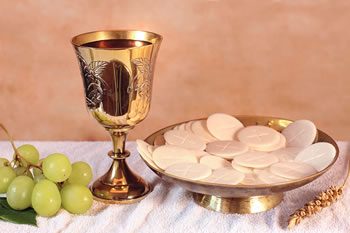My Sacrifice and Yours
At the start of the Liturgy of the Eucharist, after the preparation of the offertory gifts there is the Prayer over the Offerings. The Collect and the Communion Prayer are both introduced by the standard “Let us pray”, but this prayer has a more complex introduction called the Orate Fratres.
Like most prayers it is named for its opening words in Latin, the text is:
Orate, fratres, ut meum ac vestrum sacrificium acceptabile fiat apud Deum Patrem omnipotentem.
We used to translate this as:
Pray, brethren, that our sacrifice may be acceptable to God, the almighty Father.
We now render it as:
Pray, brethren (brothers and sisters), that my sacrifice and yours may be acceptable to God the almighty Father.
This prayer is newer than much of the liturgy, the oldest occurrence of it being found in Italian manuscripts from the 1100s. Some liturgists have suggested that it might have come from the Bishop exhorting the priests and deacons around him to silently pray with him. Even if that were the case, the scope must have rapidly expanded to include the entire congregation, as some old manuscripts have “fratres et sorores” – brothers and sisters – instead of “fratres”. The new translation nods to this by giving the priest the option of saying “brothers and sisters”.
Notice the Latin text has “meum ac vestrum” rather than “nostrum” (“mine and your” rather than “our”) – which is reflected in the present translation having the slightly clumsy “my sacrifice and yours” instead of the earlier “our sacrifice”. The words of the rite are inviting us to reflect on what is being offered and by whom.
The ‘yours’ points to the bread and wine which “are the work of human hands”, they have come forward from the congregation, and as mentioned in this column in the November Messenger of last year, they used to be gifted by members of the congregation. It also invites the participants to identify themselves as the body of Christ which is being offered. St Paul exhorted the Christians of Rome:
I appeal to you therefore, brothers and sisters, by the mercies of God, to present your bodies as a living sacrifice, holy and acceptable to God, which is your spiritual worship. (12:1)
A religious sister of happy memory who prayed for me often, used to tell me “I put you into the chalice this morning.” She was consciously joining her petitions to those of the liturgy as the offering was being made. So many, many things are being offered up in that moment by the congregation.
The ‘mine’ points to the role of the bishop or priest, offering gifts and sacrifice to God on behalf of the people (cf Hebrews 5). As Vatican II put it: “Through the ministry of the priests, the spiritual sacrifice of the faithful is made perfect in union with the sacrifice of Christ. He is the only mediator who in the name of the whole Church is offered sacramentally in the Eucharist and in an unbloody manner until the Lord himself comes.” (PO 2) So the celebrant is offering the bread and wine sacramentally, in one of many masses being offered that day.
At the deepest level it is one sacrifice which is only Christ’s and which is offered once and for all. It is his self-offering to the Father which the liturgy of the Eucharist draws us all into. Between Calvary and the Second Coming we celebrate the Lord’s Supper as he commanded us to do, and we pray to God the Father:
May the Lord accept the sacrifice at your hands for the praise and glory of his name, for our good and the good of all his holy Church.

 Entries(RSS)
Entries(RSS)